Top 20 Types Of Songbirds – Meet the Cutest and Most Vibrant Songbirds In North America
Are you an avid birdwatcher or simply a nature lover captivated by the melodious songs of birds? There’s no denying the magical effect songbirds have on us, both through their enchanting tunes and vibrant colors.
There are different types of songbirds, all unique in their own right. In North America alone, there are over 5,000 avian species classified as songbirds!
However, we cannot cover all them in a single article, so today we’ll introduce you to the top 20 types of songbirds found in this region and explore their unique characteristics that make them stand out from the crowd.
Key Takeaways
- North America is home to over 5,000 avian species classified as songbirds.
- The top 20 types of songbirds found in North America include the Northern Cardinal, American Robin, Eastern Bluebird, Black-capped Chickadee, American Goldfinch and many more.
- Songbirds contribute significantly to their ecosystem through seed dispersal and insect control while providing aesthetic value with their beauty and musical prowess.
- To attract songbirds to your backyard or garden, consider providing them with food sources like sunflower seeds or incorporating native plants into your landscape. Avoiding pesticide use also helps protect these delicate creatures and other beneficial insects that help maintain plant life in our ecosystem.
Top 20 Different Types Of Songbirds Found In North America
North America is home to a diverse array of songbird species, including but not limited to the following famous five (5):
- Northern Cardinal
- American Robin
- Eastern Bluebird
- Black-Capped Chickadee
- American Goldfinch
In no special order, these are the top 20 most popular types of songbirds that are available in our own backyard here in North America:
1. Northern Cardinal
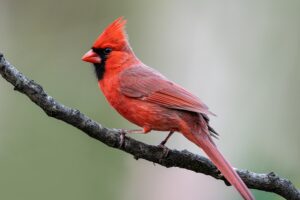
Northern Cardinal
As one of the top 20 types of songbirds found in North America, the Northern Cardinal is a true delight for bird enthusiasts and casual observers alike.
The Northern Cardinal belongs to a group that includes other brightly colored songbirds such as grosbeaks, buntings, and tanagers. This captivating backyard visitor is not only visually stunning but also possesses a melodious song that adds life to any outdoor space.
Attracting cardinals to your yard can be achieved by providing food sources like sunflower seeds or suet cakes while incorporating native plants into your landscape.
Their continued presence serves both ecological roles in seed dispersal and pest control while also enriching our lives with their beauty and musical prowess.
2. American Robin
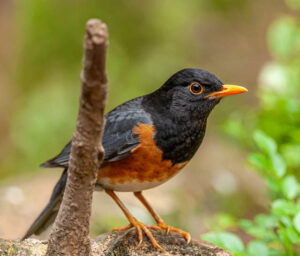
American robin
The American Robin, one of the most familiar and widespread songbirds in North America, showcases a large round body with long legs and a fairly lengthy tail.
Not only are these captivating birds visually pleasing, but they also contribute significantly to their ecosystem through seed dispersal and insect control. Their melodic songs further emphasize their cultural significance in various pieces of literature and music throughout history.
3. Eastern Bluebird
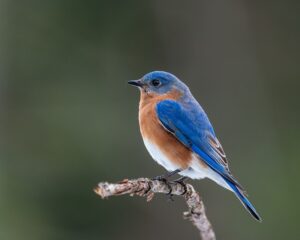
Eastern blue bird
Eastern Bluebirds, with their vibrant azure plumage and melodious songs, have captured the hearts of bird enthusiasts across North America.
Found among the top 20 types of songbirds on the continent, these charming creatures can be easily spotted in open woodlands, meadows, and even suburban gardens from New England all the way down to Mexico and Central America.
Unfortunately, Eastern Bluebird populations experienced a significant decline in the early twentieth century due to competition for nesting sites with aggressive species such as House Sparrows and European Starlings.
Conservation efforts have since helped stabilize their numbers as humans provide nest boxes mimicking their preferred natural tree cavities. With a diet primarily comprised of insects including spiders, grasshoppers, and beetles that they forage from perches or mid-flight sallies —their insectivorous habits make them beneficial to human habitat by controlling pest populations.
4. Black-Capped Chickadee

Black-Capped Chickadee
The Black-capped Chickadee is a small, lively songbird that belongs to the top 20 types of songbirds found in North America. It can be easily identified by its black cap and white cheeks framing its face.
This bird species exhibits active behavior that enlivens winter woods with their chick-a-dee callnotes when flying in little flocks. The Black-Capped Chickadee is found in Canada, Alaska, and even as far south as New Mexico’s mountains.
Attracting this little bird to your garden requires providing food – offering sunflower seeds or peanut butter suet cakes will encourage their visits – water source such as a birdbath or small pond during hot days, and shelter made possible through well-designed nest boxes placed at least 10 feet above ground level.
Incorporating native plants like Serviceberry trees or Eastern Red Cedars provides these birds with fruits they love to eat.
5. American Goldfinch

American Goldfinch
The American Goldfinch is a popular and iconic songbird found throughout North America, known for its brilliant yellow plumage. This feeder bird is commonly seen gathering in flocks to feed on thistle seed at backyard feeders during the winter months.
These beautiful birds are quite small, measuring just 4-5 inches long, with short bills and forked tails.
In addition to their striking appearance and friendly demeanor, American Goldfinches play an important role in our ecosystem by dispersing seeds from plants like thistles and other weeds.
Not only do they provide ecological benefits, but they also have cultural significance as symbols of joy, freedom, and happiness in many cultures.
6. Song Sparrow
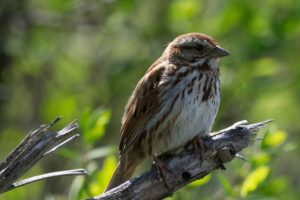
Song Sparrow
One of the most common North American sparrows, the Song Sparrow is a medium-sized New World sparrow known for its melodious and complex song.
This bird can be found in every state of the Union and Canadian province, making it one of the most familiar birds across North America. The Song Sparrow’s signature tune features several variations, which are unique to each individual bird.
While some people may mistake them for other small brown birds like house sparrows or finches at first glance, experienced birdwatchers will recognize these charming little creatures easily by their unique song and physical characteristics.
They have reddish-brown streaks on their backsides with grayish breasts that often have spots near the lower neck area. Their bills are also relatively long compared to many other types of passerines due to their preference for insect-heavy diets during breeding season while seeds prevail when winter comes around.
7. Cedar Waxwing

Cedar Waxwing songbird
One of the top 20 types of songbirds found in North America is the Cedar Waxwing. These medium-sized birds have short necks, wide bills, and large heads with a distinctive crest on their head.
They are known for their beautiful appearance as they have waxy red tips at the end of their secondary feathers that make them stand out from other birds.
During breeding season, these birds are found in parts of North and Central America and migrate south during the winter months. Their unique physical characteristics make them an attractive sight for bird watchers and nature enthusiasts alike.
8. Carolina Wren
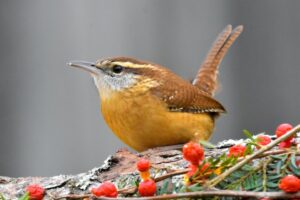
Carolina Wren
The Carolina Wren is a small songbird that can be found in the eastern part of North America. It has a distinctive reddish-brown color on its back and buff-orange coloring beneath, making it easy to spot.
The Carolina Wren is known for its musical voice, and birdwatchers enjoy listening to their virtuoso-like calls. This species of wren prefers to make its nest in low shrubs or brush piles, usually near the ground.
Carolina Wrens are meticulous builders who construct domed nests with side entrances out of sticks, leaves, mosses, rootlets, and other fine materials they find in their environment.
These birds have an important ecological role as insect predators; they help maintain populations of harmful insects like beetles and caterpillars under control.
9. House Finch

House Finch
The House Finch is one of the top 20 types of songbirds found in North America. These small birds are easily identifiable by their rosy-red coloring on their head, breast, and rump, as well as brown streaks on their back and wings.
They have a delightful warbling song that makes them a favorite among birdwatchers. Interestingly enough, House Finches have become one of the most widespread and common species across the United States due to accidental human introductions.
If you want to attract House Finches to your backyard, consider providing them with a variety of food options such as sunflower seeds or thistle seed feeders.
You can also incorporate native plants into your garden that will provide them with both shelter and nourishment throughout the year. The key is to avoid using pesticides that could harm these delicate creatures and other beneficial insects like bees or butterflies that help maintain plant life in our ecosystem.
10. Yellow Warbler

Yellow Warbler songbird
Yellow Warblers are small, but beautiful songbirds that can be found throughout most of North America. Known for their buttery yellow coloring and whistled songs in the summer months, these birds are a favorite among birdwatchers and nature enthusiasts alike.
Interestingly enough, while males have the telling bright yellow color, females can appear slightly browner with more white on their bellies.
As one of the top 20 types of songbirds found in North America, Yellow Warblers play an important role in our ecology as well as our culture and aesthetics. Being part of the warbler family means they share many physical characteristics including preference for habitats like forests or dense low vegetation areas along water bodies where they feed on insects such as caterpillars or spiders.
11. Common Grackle
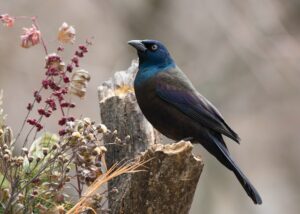
Common Grackle
The Common Grackle is a large blackbird that is native to North America. They can be found as a resident or short-term migrant throughout much of the continent, with their range stretching from southern Alaska all the way down through Central America.
These birds often congregate in large flocks and are typically seen foraging for food on the ground or perching high up in trees.
While grackles may not be everyone’s favorite bird due to their loud calls and sometimes aggressive behavior, they do play an important ecological role by helping control insect populations and spreading seeds through their droppings.
Additionally, many people appreciate them for their unique vocalizations and striking appearance, which includes glossy black plumage and piercing yellow eyes.
12. House Sparrow
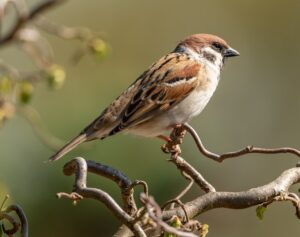
House Sparrow
The House Sparrow, Passer domesticus, is a common bird species found in North America. Originally from Europe, it was introduced to the continent as early as 1852. While they may seem like an average bird at first glance, House Sparrows have some interesting social habits.
They live in organized units that resemble military hierarchies led by the male with the biggest black patch on his head and throat.
However, the presence of House Sparrows comes with its fair share of problems. As an invasive species, they have displaced native birds from nesting sites and food sources.
Their loose nests are notorious for littering around buildings and causing sanitation issues.
13. American Crow

American Crow
The American Crow is a common passerine bird found throughout North America, known for its distinctive hoarse vocalizations and intelligence.
They are members of the corvid family and are often seen perched high in treetops or flying across open fields.
Despite being notorious scavengers, American Crows play important ecological roles by helping to regulate populations of insects and small animals. They also have cultural and aesthetic value as symbols of wisdom, intelligence, and adaptability in many indigenous cultures around the world.
14. Eastern Towhee

Eastern Towhee
The Eastern Towhee is one of the most fascinating types of birds in North America, known for its large size and distinctive callnote. These ground-dwelling birds are commonly found throughout many regions of North America, from southern Saskatchewan and Quebec to Florida and eastern Texas.
As part of the top 20 types of songbirds in North America, Eastern Towhees belong to the family Passerellidae.
Eastern Towhees usually breed in brushy areas across eastern North America during summer months. Despite being a relatively common bird species, they remain an exciting sight for bird watchers due to their beauty and uniqueness.
In certain parts of Southeastern US like Florida where towhees have white eyes, locals often refer to them as “Chewinks“.
15. Baltimore Oriole

Baltimore Oriole songbird
The Baltimore Oriole is a stunning bird, with its bright orange plumage and black wings. It is one of the top 20 types of songbirds found in North America, and it can be spotted in open woodlands, gardens, and parks during the breeding season.
Orioles are known for their hanging woven nests that they construct from plant fibers and grasses.
Baltimore Orioles are migratory birds that typically spend their winters in Central or South America before returning to North America for breeding season. Their diet consists of insects, fruits such as berries and oranges, and nectar from flowers.
As fruit-eaters, these birds play an important role in seed dispersal and plant reproduction. Baltimore Orioles face threats like habitat loss due to deforestation or urbanization; using native plants in your garden can help provide food sources for them while preserving natural habitats.
16. Red-Winged Blackbird

Red-Winged Blackbird
The red-winged blackbird is a medium-sized songbird and one of the most diverse types found in North America, with at least 20 subspecies.
Males measure approximately 17 to 23 centimeters in length and weigh between 32 to 77 grams. The distinctive feature of male red-winged blackbirds is their bright red and yellow shoulders, while females are smaller and brownish in color.
These birds are commonly found in wetland areas where they feed on insects and seeds. Unfortunately, the population of red-winged blackbirds has been declining rapidly due to habitat loss, leading conservationists to raise concerns about their survival.
To help preserve this incredible species for future generations, it’s important that we take action now by providing protection for wetlands habitats where they thrive as well as reducing pesticide use that can harm them directly or indirectly through food sources such as insects.
17. Ruby-Throated Hummingbird

Ruby Throated Hummingbird
The Ruby-throated Hummingbird is one of the most fascinating birds in North America and a common feeder visitor. These tiny birds are known for their vibrant colors, with males having iridescent ruby-red throats that shimmer in the sunlight, while females have iridescent green backs and white bellies.
Ruby-throated Hummingbirds are also impressive flyers; they can fly forwards, hover mid-air, upside-down or even backwards as they feed on nectar from flowers.
For bird watchers or enthusiasts alike wanting to attract these beautiful creatures into their garden, providing essential needs such as food sources like sugar water and native flowering plants is necessary.
It’s best to avoid pesticides that may be harmful to them as well as investing in hummingbird feeders where needed. Incorporating an appropriate habitat such as trees or shrubs would favorably influence more visits from this species.
18. White-Throated Sparrow

White Throated Sparrow
The White-throated Sparrow is a small, distinctive bird with a striking black and white striped head, tan or grayish-brown body, and a bright white throat.
These sparrows are commonly found across North America in forests with dense undergrowth or shrubs.
Adult White-throated Sparrows occur in two plumage types: white-striped (bright) or tan-striped (dull). Interestingly, studies have shown that male birds of both types prefer females with bright stripes while female birds show no preference between males of either type.
19. Dark-Eyed Junco

Dark-Eyed Junco
The Dark-eyed Junco is a popular backyard bird and one of the top 20 types of songbirds found in North America. They are known for their highly variable plumage, with some populations exhibiting entirely dark gray feathers, while others have a brownish-gray head and reddish-brown back.
In colder regions, the Dark-eyed Junco is commonly referred to as “Snowbirds” or “Winter birds” due to their migration patterns that bring them south during the winter months.
Belonging to the New World sparrows family, Dark-eyed Juncos have a distinctive dark upper body with white outer tail feathers visible when they take flight.
These small birds play an important ecological role in seed dispersal and insect control and are also popular targets for birdwatchers year-round.
20. Purple Finch
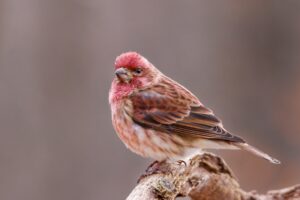
Purple Finch
The beautiful Purple Finch is one of the top 20 songbirds found in North America. Its ground-color is a bright emerald-green with sparse black dots and streaks, while the male’s plumage is a stunning mix of pink and red with brown wings.
Their thick beaks help them to crush seeds and extract their contents. These birds have a wide distribution across forests and urban environments throughout North America, except for northern areas.
Purple Finches are often admired by birdwatchers for their melodious songs which can vary depending on different regions and seasons. With their stunning appearance, pleasant calls, and unique feeding habits, these birds play an essential ecological role as seed dispersal agents while adding cultural value to our environment through their aesthetic appeal.
Characteristics And Habitats
Songbirds have unique physical characteristics that make them easily recognizable, and they prefer specific habitats to thrive. From the colorful feathers of the Baltimore Oriole to the plain brown plumage of the Song Sparrow, each species has its own distinct look and preferred living environment.
1. Physical Characteristics
Songbirds come in a wide variety of shapes and sizes, with unique physical characteristics that have adapted to their specific habitats and lifestyles. For example, the Northern Cardinal is known for its bright red feathers, bushy crest, and large bill used for cracking seeds.
American Goldfinches have vibrant yellow plumage during breeding season but molt into a more subdued coloration in the winter months. Meanwhile, Cedar Waxwings are recognized by their sleek gray-brown feathers and striking black mask around their eyes.
Additionally, songbirds possess remarkable vocal abilities that allow them to produce complex songs using specialized vocal organs called syrinxes located at the base of their tracheas.
Each species has a unique song pattern that plays an important role in communication among individuals within the flock or mating rituals between male and female pairs.
2. Preferred Habitats
Each species of songbird has unique requirements for their preferred habitats. Some prefer to nest in trees and shrubs found in forests, while others are commonly seen in urban and suburban areas.
Other songbirds like the American Goldfinch and Cedar Waxwing will primarily feed on seeds and fruits from trees such as birch, maple, elm, cherry, and oak. It’s important to note that different types of habitat fragmentation can have negative impacts on many bird species’ breeding success rates.
The natural habitat is needed to provide food sources necessary to sustain these birds during migration periods.
Importance Of Songbirds
Songbirds play an important ecological role by controlling insect populations, pollinating plants, and spreading seeds. They also have significant cultural and aesthetic value as they are often depicted in art, literature, and music.
1. Ecological Roles
Songbirds are a vital part of healthy ecosystems, playing numerous ecological roles that contribute to the overall balance and diversity of the environment. Many songbird species help with pollination by spreading pollen from flower to flower as they feed on nectar.
They also play a crucial role in insect control, especially during breeding season when they need an abundance of insects to feed their young.
Moreover, songbirds serve as ecological indicators revealing important information about environmental health issues such as pollution levels or habitat loss. The presence or absence of particular bird species can provide valuable insight into ecosystem conditions and trends over time.
Thus, efforts to conserve biodiversity should include measures aimed at preserving vital habitats needed by these birds through strategies like restoring degraded habitats or ensuring protected areas remain intact.
2. Cultural and Aesthetic Value
Songbirds have immense cultural and aesthetic value, making them an integral part of human societies. People’s appreciation for songbirds transcends their ecological importance as they symbolize natural beauty and serve as a source of artistic inspiration.
For instance, Baltimore Orioles were once considered to be symbols of royalty in America during the colonial period.
Furthermore, songbirds’ aesthetic value plays a crucial role in how people perceive wildlife conservation efforts. Birds with unique colors and patterns often have higher trade values in illegal poaching activities threatening their populations globally, including some species on the list of top 20 types of songbirds found in North America.
In general, people tend to appreciate more attractive bird species for their visual appeal rather than for their ecological roles or biodiversity significance.
How To Attract Songbirds
To attract songbirds to your garden, provide food, water, and shelter. Incorporate native plants and avoid using pesticides.
1. Provide Food, Water, and Shelter
To attract songbirds to your backyard, it is essential to provide them with the three things they need the most: food, water, and shelter. Here are some ways you can provide these necessities:
- Set up bird feeders that offer a variety of seeds and nuts that different species of birds prefer.
- Plant native trees, shrubs, grasses, and flowers that produce fruits and seeds favored by songbirds.
- Install nesting boxes or natural cavities in trees to offer secure places for songbirds to raise their young.
- Add birdbaths or other water sources such as fountains or ponds for drinking and bathing during hot summer days.
- Incorporate protective cover like bushes or evergreens where songbirds can hide from predators and harsh weather conditions.
Providing physiological needs such as water, food, and shelter is the best way to attract birds to your backyard. By incorporating these elements into your backyard landscaping design, you can create an inviting space where songbirds will feel welcome, safe, and comfortable.
2. Incorporate Native Plants
Growing native plants is an excellent way to attract songbirds to your backyard. Native plants provide a balanced diet of seeds and fruit for birds, making them a more nutritious option than non-native species.
For example, sunflowers, elderberries, and serviceberries are all great options that can attract various types of songbirds.
When planting your garden or landscape design, it’s essential to consider avian wildlife and ecosystem health. Incorporating pollinator-friendly plants like milkweed and butterfly weed can not only attract songbirds but also help essential pollinators like bees thrive.
It’s also important to consider soil health when selecting plant species for your garden or landscape design; healthy soil encourages root growth and provides nutrients vital for the survival of birdlife in the area.
3. Avoid Use Of Pesticides
To attract songbirds to your garden, it is crucial to avoid using pesticides. Pesticides are toxic chemicals that can harm birds in various ways, from decreasing their food sources to impairing their reproductive abilities and weakening their immune systems.
Unfortunately, many bird species have been linked to declining populations due to the use of pesticides. The decline in songbirds worldwide has been linked directly to the world’s most widely used insecticide, which can cause adverse effects on egg production and other aspects of breeding biology.
Therefore, individuals who want to attract songbirds should practice organic gardening methods by avoiding pesticide use and focusing instead on natural pest control alternatives such as planting native plants or creating habitats for beneficial insects like ladybugs or mantises.
Conclusion
So there you have them: the top 20 types of songbirds found in North America are a diverse and beautiful group of birds. Their unique songs, physical characteristics, and preferred habitats make them fascinating to study and watch.
Songbirds play important ecological roles by eating insects that harm plants and trees, making them valuable allies for humans. As birdwatching continues to grow as a popular hobby around the world, it’s important to appreciate these amazing creatures and their cultural significance.
FAQs:
1. What are some of the most common types of songbirds found in North America?
- American Robin
- Blue Jay
- Northern Cardinal
- Black-capped Chickadee
- American Goldfinch
- House Sparrow
- European Starling
- Mourning Dove
2. How can I identify different types of songbirds based on their appearance?
- Color: Many songbirds have distinctive colors that can help you identify them. For example, the American Robin is a bright orange-red on the breast and belly, with a gray back and head. The Blue Jay is a bright blue bird with a white underside and a black crest.
- Size: Songbirds come in a variety of sizes, from the tiny Ruby-throated Hummingbird, which is only about 3 inches long, to the larger Northern Cardinal, which is about 9 inches long.
- Shape: The shape of a songbird’s body can also be helpful in identification. For example, the Black-capped Chickadee has a small, round body with a short tail, while the American Goldfinch has a longer, slender body with a long tail.
- Behavior: Some songbirds have distinctive behaviors that can help you identify them. For example, the Blue Jay is a very vocal bird that often makes loud calls. The American Goldfinch is a social bird that often gathers in flocks.
3. Are there any specific songs or calls unique to particular species of songbirds?
Yes, there are many specific songs or calls that are unique to particular species of songbirds. These songs and calls are often used to attract mates, defend territory, or communicate with other members of the flock.
For example, the American Robin has a distinctive song that is often heard in springtime. The Blue Jay has a variety of calls, including a loud “jay” call that is often used to warn other birds of danger.
4. What is an easy way to attract songbirds to my backyard?
- Plant native plants: Native plants provide food and shelter for songbirds.
- Put out a bird feeder: A bird feeder is a great way to attract songbirds to your backyard, especially during the winter months.
- Leave some brush or dead trees: Songbirds often use brush and dead trees for nesting material.
- Keep your yard free of pesticides: Pesticides can harm songbirds, so it’s important to keep your yard free of them.
5. What is the best songbird?
There is no one “best” songbird, as different people have different preferences. However, some of the most popular songbirds include:
- American Robin
- Blue Jay
- Northern Cardinal
- Black-capped Chickadee
- American Goldfinch
- House Sparrow
- European Starling
- Mourning Dove
- Ruby-throated Hummingbird
6. What is the most common songbird in America?
The most common songbird in America is the House Sparrow. House Sparrows are found in all 50 states and are very adaptable to different habitats. They are also very aggressive and can displace native songbirds from their nesting sites.
editor's pick
latest video
news via inbox
Nulla turp dis cursus. Integer liberos euismod pretium faucibua





